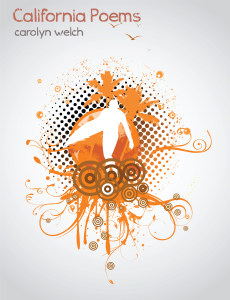© Carolyn Welch
Author of California Poems, Moon Willow Press (2012)
In the late 1990s I drove Laguna Canyon Road for the first time. It goes from near the Irvine Spectrum Center to the Pacific Ocean, though I had driven that first time from the next town east, Laguna Hills. I fell in love with that shaded canyon road, flanked on both sides by the Pacific foothills. Along the way to the sea, I began to see the artistic community in motion: shops, murals, and statues. The area is popular for plein air artists, due to the light near the ocean. Laguna Beach itself is a crowded but interesting entity. It’s probably best to bicycle in as parking is fierce. Despite the natural beauty, the canyon road and surrounding arteries were always busy, and now are much worse than back then. At the end, you get to see the ocean, though, at the intersection of Pacific Coast Highway. Even still, when I see an ocean come into view, I am filled with wonder and amazement. That will never change despite everything else changing.
When I lived in the area, I usually headed south on the PCH until I got into sleepier towns and beaches, like San Clemente, San Juan Capistrano, and San Onofre. But those areas, like others north of Laguna Beach, became more and more congested throughout the years. Originally home to nothing much but orange groves, coyotes, and natural habitat—dry rolling hills, desert, sparse trees, and all the wildlife that goes with it—southern California’s development makes up the largest metropolis I’ve ever seen. It’s seemingly only on a lonely stretch of road between Los Angeles and San Diego that one gets a sense of how things used to be, but with a nuclear station and a large naval base nearby, you know you haven’t entered paradise at all.
The coyotes still howl at night in certain areas. I lived in one of those places, and the beautiful coyote song often filled the air. But now, more development encroaches. The coastal highways that used to be more isolated are now a rich person’s playground, with fancy eateries and modern malls erected all over the place. I was saddened when I went back years later to see just how much that area had changed; I was glad to have moved to a more rural area since. I remember once, when passing Long Beach’s Terminal Island, seeing a coyote walking within the steel matrix. It was a haunting sight, as if two worlds collided and the constructed world had won, leaving behind a wandering ghost.
Increased wildfires, extreme heat, earlier mountain snow melt, threatened water supplies, coastal flooding and saltwater contamination, ecosystems and natural habitats dwindling, and harder-to-grow crops are just some tragedies since my earliest time in southern California.
In those early years, though, I made the ocean my playground, and I was thrilled to see that Surfrider Foundation was working hard to protect the local beaches, ocean, and waves. They fight for reduction of plastics, coastal and ocean preservation, beach access, and clean water. I remember some of their signs at my favorite beaches, which posted water quality reports, health advisories, and warnings about contaminated water, bacteria levels, rip currents, and so on. It felt good, like someone was watching out for us.
***

With permissions, I’m posting one of my poems, which was published years ago at Moon Willow Press.
Future Artifacts
Digging through alluvium deposits,
they’ll see broken teeth, bullets,
rusted hulks, sunken concrete walks,
and cuneiform of graffiti, and ask:
Who did these things? What were they like?
We’ll be bowsed and carbon-dated;
they’ll find diffusion from London to Hollywood:
flaxen doll heads, toaster coils, and silicon.
Fallen streetlamps poking through loam,
and crumbled temples divulging gold.
Our matrices will be filled with midden:
polyester fringe from the streets,
diamonds and emeralds on every
twentieth skeletal finger bone,
television controls, color-coded wire strands,
and obtuse signs that flashed on mountain
passes and stood sentinel on the
outskirts of now rubble city mounds.
Coprolitic studies will reveal the gumbo:
hormonally enhanced and DNA-modified protein,
genetically altered strains of vegetable foodstuffs—
the dung found amid articles of worship:
crosses, banners, beads, gates, and stars,
multi-lingual prayerbooks and hymnals.
The central meeting places will have
converged and died, ocean to ocean—
leaving a giant trenchcoat of many pockets,
from which they will pull rabbit foot and ruby,
ivory tusk and coin, paw and key—
and excavate our bodies from the linings.
They’ll put who we were in their top hat.